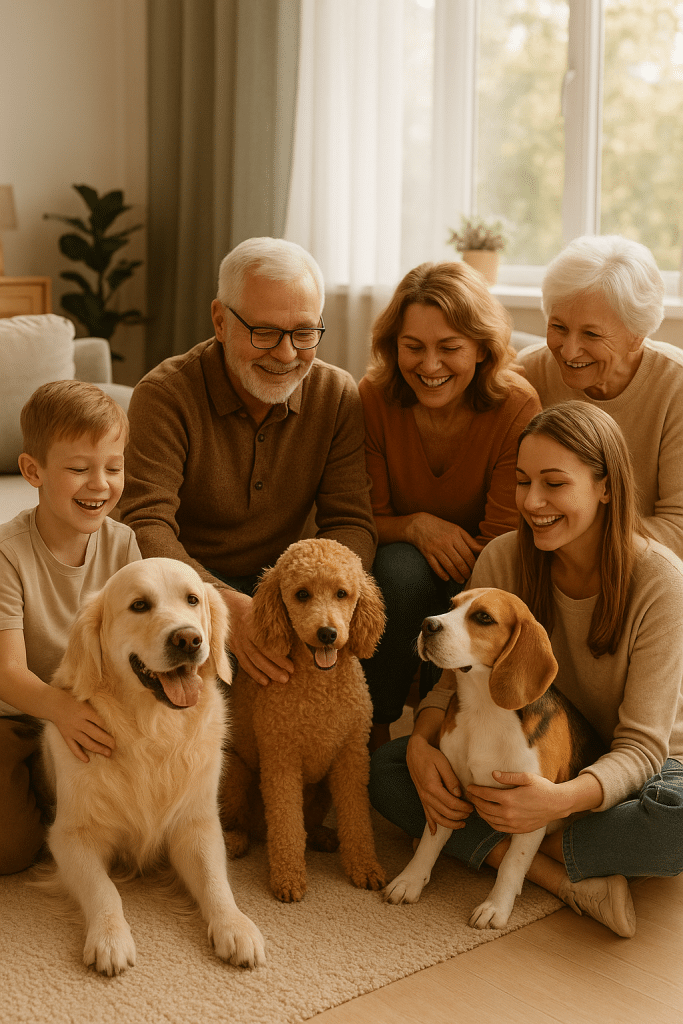Choosing the perfect dog for your family is an exciting yet sometimes overwhelming journey. As someone who’s worked closely with families and canine experts over the years, I’ve seen firsthand how the right furry companion can bring joy, security, and endless love into a home. When searching for the best family dogs, it’s essential to consider a variety of factors—from temperament and training ease to exercise needs and compatibility with children and other pets.
In this comprehensive guide, I’ll walk you through understanding your family’s unique lifestyle, the critical traits that make a great family dog, and detailed profiles of six fantastic breeds that fit a range of household needs. Whether you live in a spacious house or a cozy apartment, have active kids or prefer calmer companions, or even if anyone in your family suffers from allergies, you’ll find tailored insights here. Plus, I’ll cover training techniques, health and grooming essentials, and adoption considerations, so you’re well-prepared to welcome your new best friend.
Let’s dive in and find the best family dogs that can become beloved members of your home for years to come.
Understanding Your Family’s Unique Lifestyle and Preferences
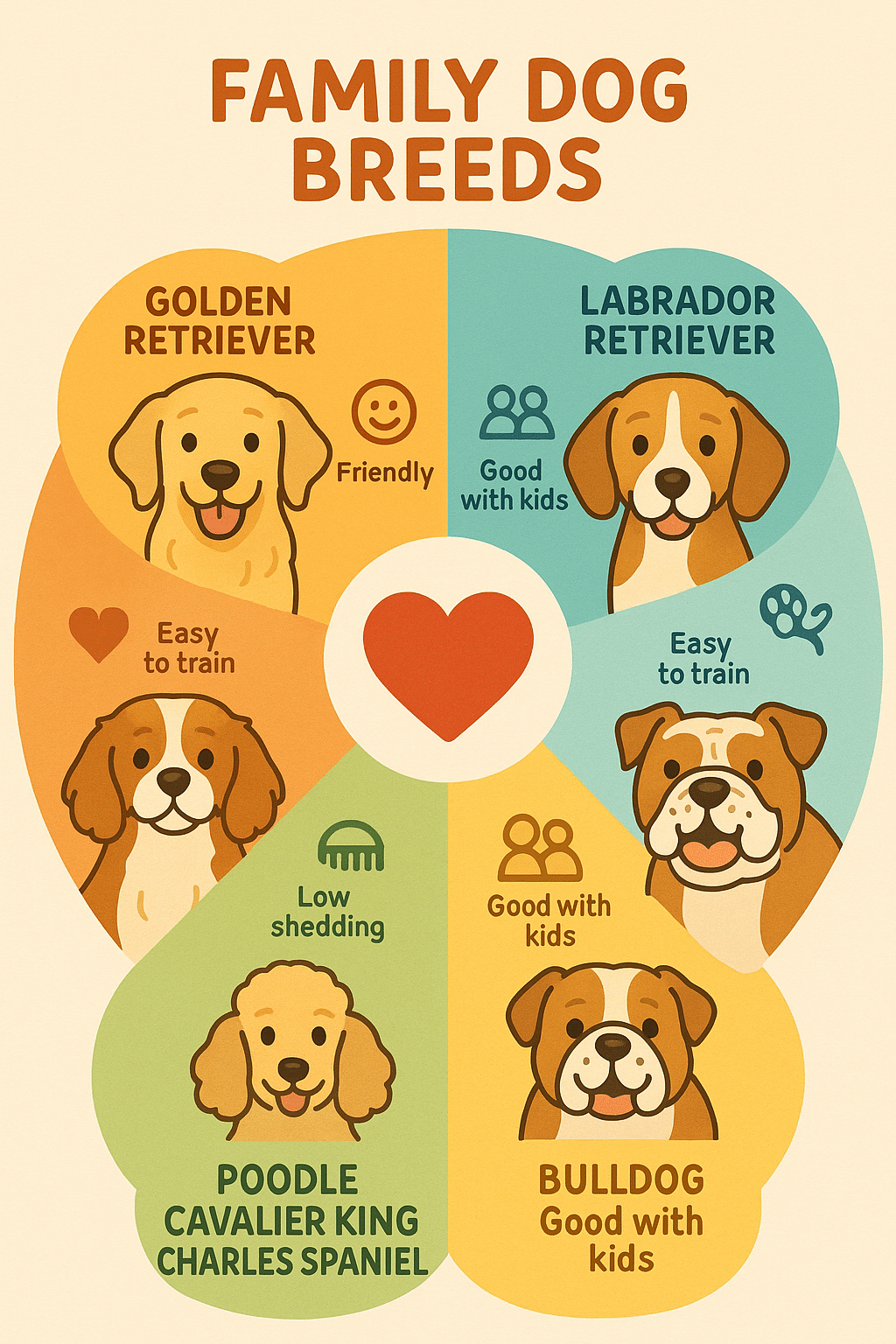
Before picking a dog breed, I always recommend families take a moment to reflect deeply on their unique dynamics. Understanding your daily rhythms, living situation, and preferences can make all the difference between a happy household and one facing frustration.
Evaluating Activity Levels and Living Space
Is your family on the go, hiking trails and spending weekends outdoors? Or do you prefer laid-back movie nights and quiet afternoons at home? Active families often need dogs that love exercise and can keep up, like Labrador Retrievers or Bearded Collies. On the other hand, if space is limited—say, a downtown apartment—smaller and less energetic breeds like French Bulldogs can be a better fit.
Living space also plays a huge role. Large breeds like Bernese Mountain Dogs require ample room to stretch and move comfortably. Conversely, breeds with lower activity requirements can adapt well to smaller spaces, but they still need daily walks and mental stimulation. Remember, a dog’s wellbeing isn’t just about size—mental needs count just as much.
Considering Allergies and Sensitivities
Allergies can be a big deal for families. If someone sneezes or coughs around dogs, consider hypoallergenic breeds or those with low-shedding coats. For instance, the Bearded Collie is not typically hypoallergenic, but with regular grooming, shedding can be managed. There are breeds better suited for allergy sufferers, and I’ll spotlight which family dogs tend to be friendlier for this group.
Assessing Experience with Dog Training
Are you a seasoned dog owner, or will this be your very first furry family member? Some breeds are easier to train, responding quickly to commands and changes, which suits first-time dog owners. Others might be more stubborn or have stronger herding instincts that require patience and consistency.
Understanding your experience level helps set the stage for success, ensuring a positive, rewarding relationship with your new pet. This guide highlights breeds with easy training requirements and those known for their calm temperaments.
Key Traits of the Best Family Dogs
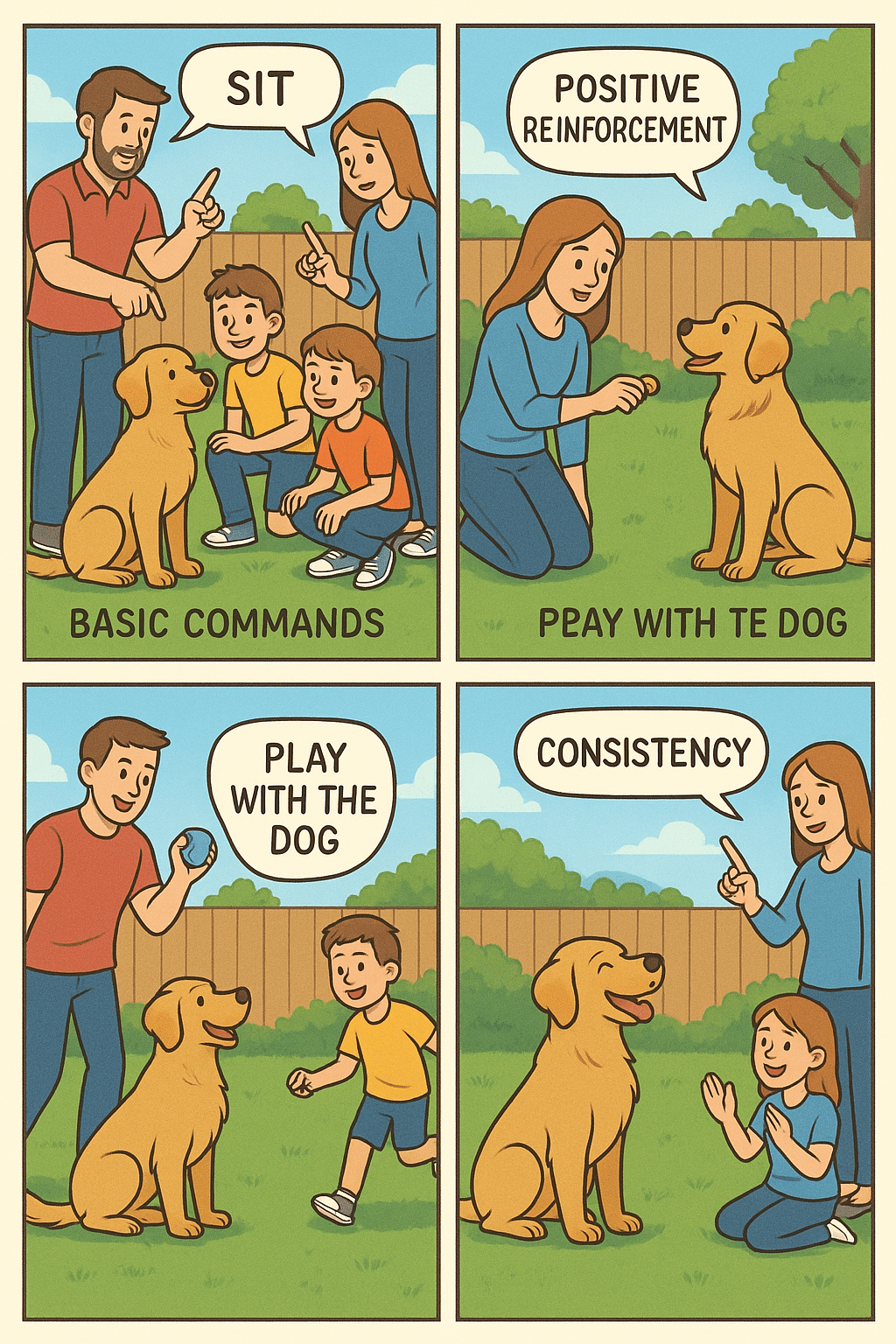
When looking for the best family dogs, certain qualities consistently stand out. From temperament to size, understanding these traits will steer you toward the breed that fits your family like a glove.
Temperament: Child-Friendly and Calm Dispositions
The ideal family dog is patient, tolerant, and gentle—especially around children. Some breeds naturally possess these qualities. For example, Bernese Mountain Dogs, often called “gentle giants,” excel at calm interactions with young kids due to their nurturing demeanor. Similarly, Labrador Retrievers are famously friendly and tolerant.
Temperament also influences how dogs cope with the noise and energy of children. Active breeds with a calm disposition tend to balance playfulness with gentleness, reducing risks of accidental harm or stress.
Size and Suitability for Different Home Types
Size matters, but it’s not everything. Large dogs often need more space and exercise but can offer significant protection and companionship. Smaller dogs suit apartments and compact homes but sometimes have a bigger personality packed into a small body.
When matching size with your home, consider factors like stair accessibility, potential for injury during play, and how family members feel about dogs that may be quite big or quite small.
Exercise and Grooming Requirements
Some family dogs need hours of daily physical activity and mental stimulation—think Bearded Collies or Bouviers des Flandres. Others thrive with just a couple of walks daily and moderate play.
Grooming varies widely too. Fluffy breeds could require daily brushing and regular professional grooming to prevent mats, while short-haired breeds like French Bulldogs need minimal maintenance.
Selecting a dog matching your lifestyle’s grooming commitment ensures a healthy, happy pet and less stress for your family.
Compatibility with Other Pets and Family Members
If other pets share your home, consider dogs known for harmonious multi-pet households. Certain breeds are more social and less territorial, reducing friction.
Family members’ ages and personalities also play a role. High-energy breeds may not be the best match for elderly family members, whereas smaller, calmer dogs can offer companionship without demanding too much physical engagement.
The 6 Best Family Dogs Explained
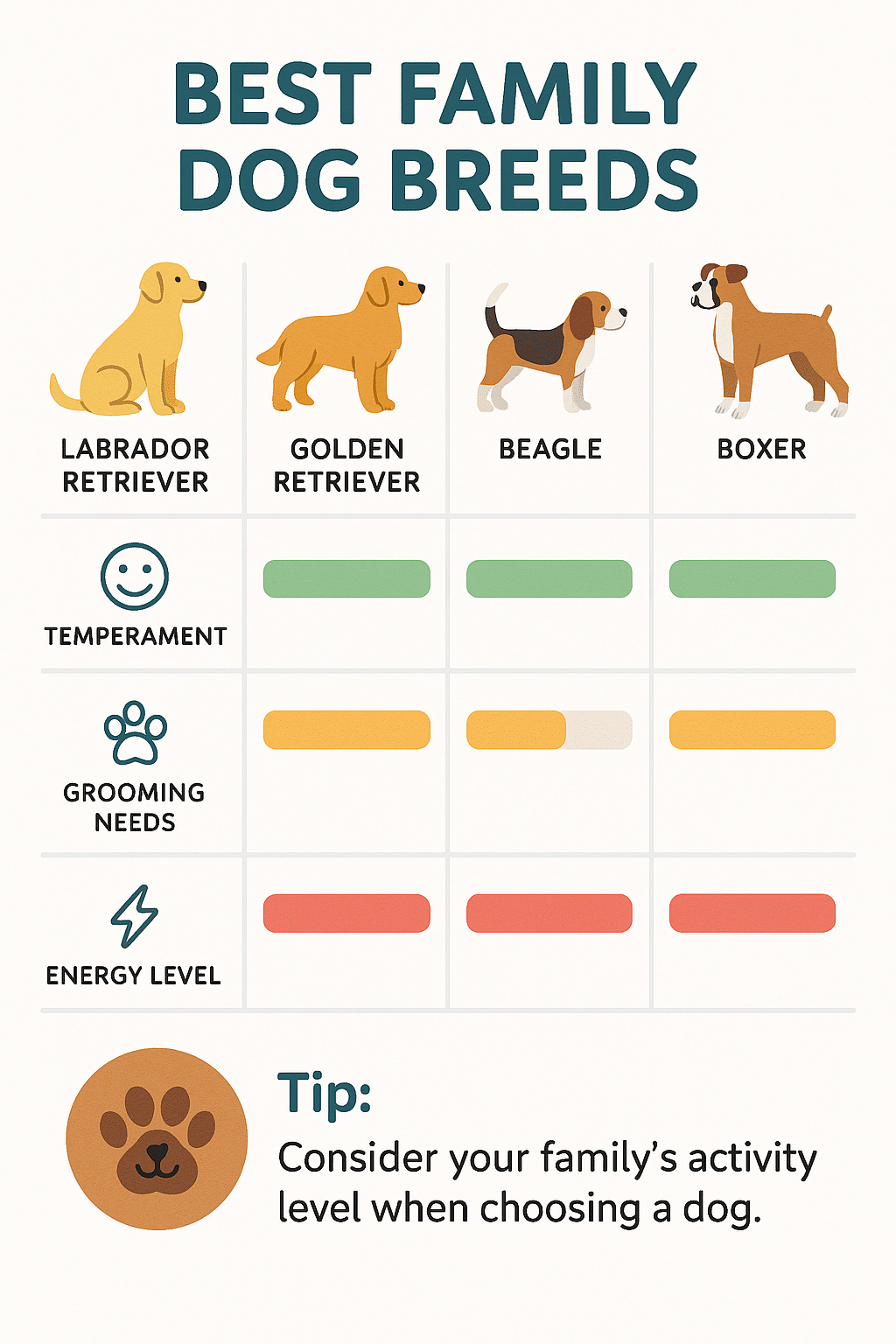
I’ve carefully curated six breeds representing a spectrum of temperaments, sizes, and lifestyles to help you find the best family dogs that fit your unique household.
Labrador Retriever: The Classic Companion for Active Families
Labrador Retrievers are, without a doubt, one of the most popular family dogs for a reason. Their friendly, outgoing nature and high intelligence make them easy to love and train.
Training Ease and Adaptability
Labradors are eager learners, responding exceptionally well to positive reinforcement training. Their desire to please means they quickly pick up commands and enjoy structured learning sessions. This trait makes them excellent for first-time dog owners and families seeking an obedient companion.
Exercise Needs and Socialization Skills
They thrive on daily exercise—think long walks, playtime, and even swimming. Labradors’ sociable character helps them get along well with children, other pets, and strangers, assuming proper early socialization is practiced.
Bernese Mountain Dog: Gentle Giants with Protective Instincts
Known for their striking tri-color coats and sizeable stature, Bernese Mountain Dogs are affectionate and devoted to family.
Grooming and Health Considerations
They do require regular grooming to keep their thick coat healthy, including brushing at least a few times per week. Health-wise, they’re prone to certain conditions like hip dysplasia, making routine vet check-ups crucial.
Interaction with Children and Large Families
Berners are patient and calm, making them excellent companions for families with several children or larger households. Their protective instincts also add a layer of security to your home.
Bearded Collie: Energetic and Enthusiastic Herding Dogs
Bearded Collies are bundles of energy that love interactive play and mental engagement.
Suitable Exercise Routines for Busy Families
They need vigorous daily exercise to channel their herding drive positively. Activities like agility courses, fetch games, and structured walks keep them happy.
Training Challenges and Rewards
Training can be a bit challenging due to their playful and sometimes stubborn streak. Consistency and positive reinforcement pay off, leading to lively but well-mannered pets.
Pembroke Welsh Corgi: Small but Intelligent and Alert
Corgis pack a lot of personality and intelligence into a small frame.
Managing Herding Instincts Around Kids
They can be a bit nippy due to their strong herding instincts, so training them to be gentle around children early on is a must.
Grooming Needs and Living Space Adaptation
Their double coats shed year-round, requiring weekly brushing, more during shedding seasons. Corgis adapt well to both apartments and houses, making them versatile.
Bouvier des Flandres: Protectors with Calm and Rational Temperaments
These dogs combine the traits of protectors and affectionate family companions.
Exercise Intensity and Mental Stimulation Requirements
Boviers need daily exercise coupled with tasks that challenge their sharp minds—from obedience drills to puzzle toys.
Integration within Multi-Pet Households
They tend to get along well with other pets when socialized properly and appreciate structured family environments.
French Bulldog: Low-Maintenance, Adaptable Companions
French Bulldogs are stars among families living in apartments or urban settings due to their laid-back nature.
Best for Apartment Living and Allergy Sufferers
Their small size and low activity requirements make them ideal for smaller homes. While not hypoallergenic, their short coats reduce shedding compared to longer-haired breeds.
Training Tips for Stubborn Breeds
French Bulldogs can be a bit stubborn, so patience combined with short, rewarding training sessions works best.
Training Techniques to Foster Positive Canine Behavior in Family Dogs
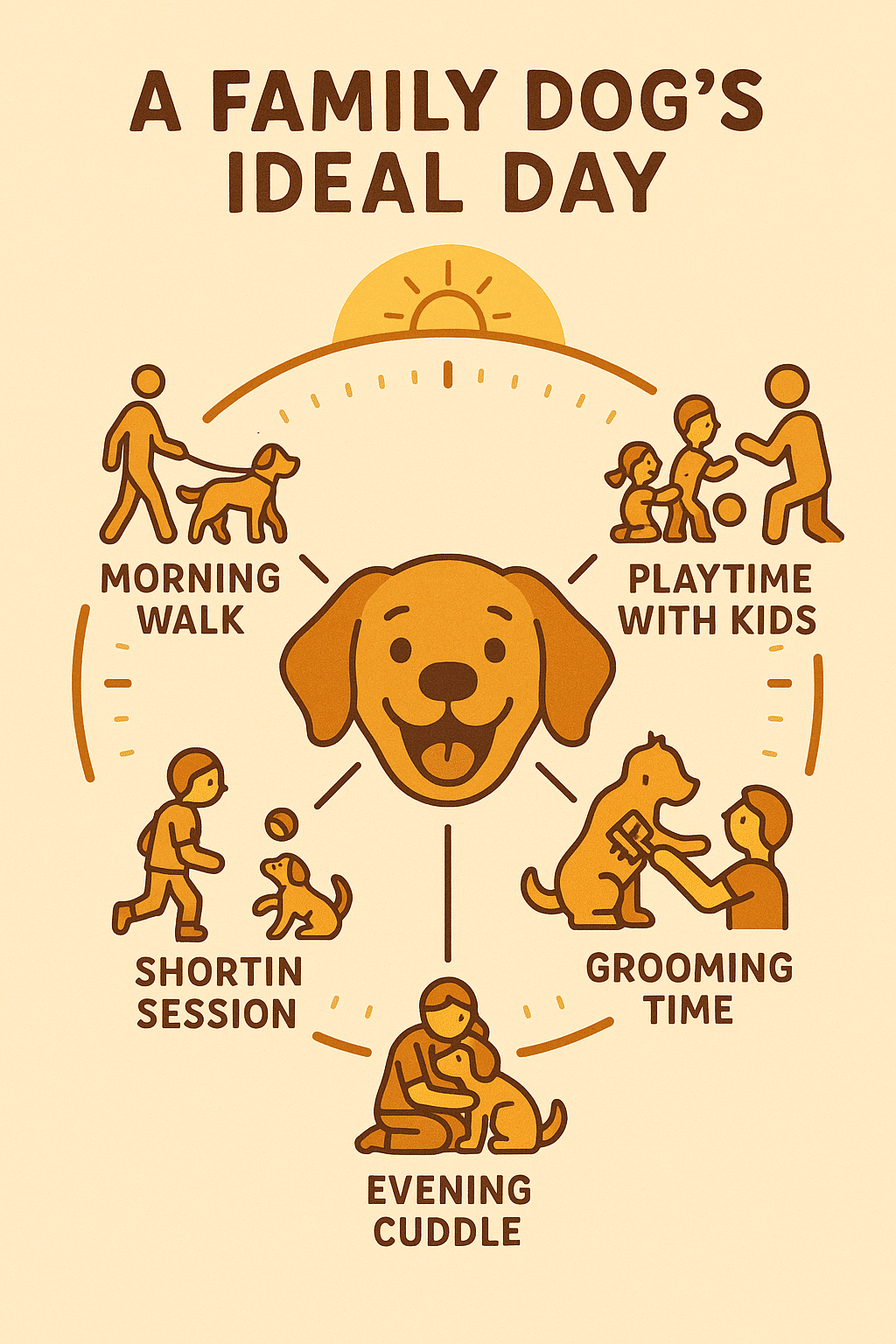
Dog training is the cornerstone of a harmonious family-dog relationship, and understanding effective techniques can save you time and frustration.
Positive Reinforcement and Consistency
Using treats, praise, and affection to reward good behavior encourages dogs to repeat those actions. Consistency is key; the whole family should stick to the agreed commands and routines.
Socialization Strategies for Children and Other Pets
Introducing your dog to kids and other pets gradually, ensuring experiences are positive, makes them less fearful or reactive. Group classes or controlled playdates often help.
Addressing Common Behavioral Challenges Early
Nipping, chewing, or excessive barking can become problematic if ignored. Early intervention with training professionals can correct these behaviors before they escalate.
Ensuring Health and Wellbeing in Your Family Dog
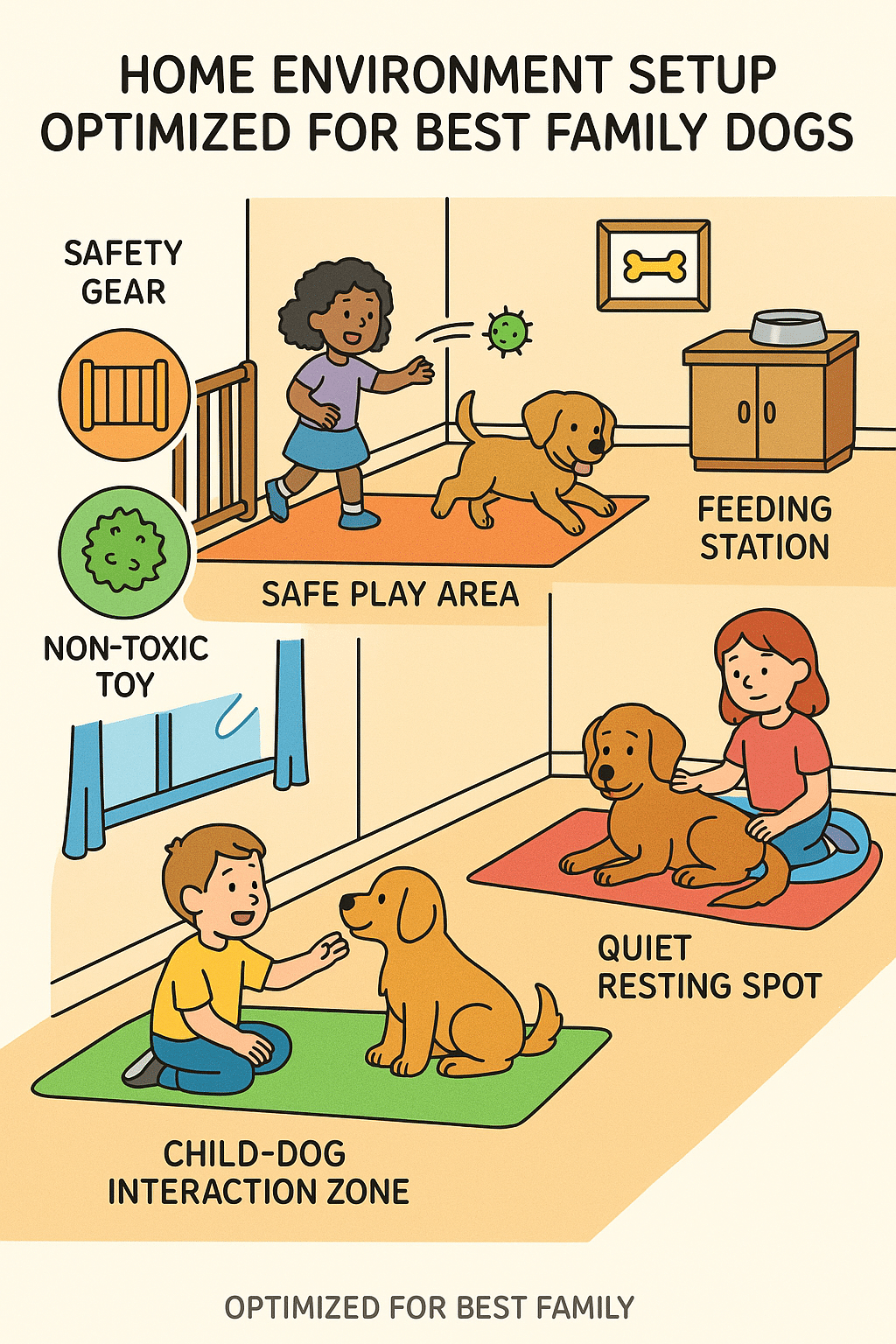
Keeping your dog healthy requires planned effort, from nutrition to vet care.
Nutritional Needs for Different Family Dog Breeds
Larger breeds like Bernese Mountain Dogs benefit from diets formulated for joint health and controlled growth. Smaller breeds may need calorie-dense nutrition to meet metabolic demands.
Regular Vet Care and Preventive Health Measures
Annual check-ups, vaccinations, dental care, and parasite control form the pillars of preventive health.
Grooming Routines Tailored to Breed and Lifestyle
For instance, Bearded Collies need daily brushing, whereas French Bulldogs require regular ear cleaning and wrinkle care.
Adoption Considerations and Finding the Right Dog for Your Home
Choosing to adopt is wonderful, and many breed-specific rescue organizations specialize in family-friendly dogs.
Rescue Organizations and Breed-Specific Adoption Tips
Look into groups like the Labrador Rescue Foundation or local breed clubs. They often assess temperament to ensure good family matches.
Matching Energy Levels and Temperaments to Your Household
Before adoption, consider a dog’s history and temperament. Meet the dog multiple times to observe behavior with family members and other pets.
Preparing Your Home and Family for a New Dog
Create a welcoming space with essentials like beds, toys, and safe areas. Educate children on respectful dog interactions and establish house rules.
Balancing Family Dynamics: Dogs for Single-Parent and Multi-Child Households
Different family setups bring unique challenges and advantages when choosing a dog.
Best Breeds for Single-Parent Families
Breeds requiring moderate exercise and easy training, like the French Bulldog or Labrador Retriever, are excellent choices for single parents balancing busy schedules.
Managing Dogs with Multiple Children and Busy Schedules
Calmer, larger breeds such as the Bernese Mountain Dog handle energy well, provided there’s structure and supervision.
Long-Term Commitment: Planning for the Future with Your Family Dog
Welcoming a dog means planning beyond the ‘puppy phase.’
Adjusting Care as Your Dog Ages
Senior dogs may need dietary tweaks, more gentle exercise, and extra vet visits. Mental enrichment slows cognitive decline.
Sustaining Training and Exercise Over Time
Training is ongoing. Reinforcing commands and regular exercise prevent behavior issues and maintain health.
Summary: Crafting a Loving Home with the Ideal Family Dog
Choosing the best family dogs doesn’t have to be daunting. By evaluating your family’s lifestyle, understanding the key traits of breeds, and preparing for training and care, you lay the groundwork for lifelong happiness. The six breeds we explored—Labrador Retriever, Bernese Mountain Dog, Bearded Collie, Pembroke Welsh Corgi, Bouvier des Flandres, and French Bulldog—offer diverse options to fit a variety of homes and scenarios.
Remember, responsible pet ownership is about commitment, patience, and love. Your new dog will reward you with loyalty and companionship beyond measure. Ready to find your family’s perfect canine match? Start today with a thoughtful decision, and enjoy every joyful moment your new friend brings.
FAQs
1. What are the best family dogs for apartments with kids?
Breeds like the French Bulldog and Pembroke Welsh Corgi are excellent for apartment living due to their size and moderate activity levels. Early training ensures they adapt well to kids and indoor environments.
2. Which are the best hypoallergenic family dog breeds?
While none of the six featured breeds are true hypoallergenic, breeds like the Bichon Frise or poodle crosses are typically recommended. Among the discussed breeds, managing shedding through grooming helps reduce allergens.
3. What are the best family dogs for first-time dog owners?
Labrador Retrievers and French Bulldogs top this list due to their trainability and adaptable temperaments. They respond well to positive reinforcement and have manageable exercise needs.
4. How do I handle grooming for a high-maintenance dog breed?
Regular brushing, scheduling professional grooming every 6–8 weeks, and establishing a grooming routine early helps high-maintenance breeds like the Bernese Mountain Dog maintain a healthy coat and skin.
5. What are the best family dogs with low shedding coats?
French Bulldogs shed less than many breeds, and diligent grooming cuts down on shedding substantially. Selecting breeds with short, tight coats generally reduces shed hair around the house.
Quick Takeaways / Key Points
- Choose the best family dogs by matching breed traits to your family’s lifestyle and space.
- Consider temperament, size, exercise, grooming needs, and compatibility with children and other pets.
- Labrador Retrievers and French Bulldogs are versatile, easy-to-train options for many families.
- Regular training, socialization, and veterinary care are essential for happy, healthy pets.
- Adoption from breed-specific rescues offers great opportunities to find well-suited family dogs.
Ready to embark on your journey to find the best family dogs that fit seamlessly into your life? With thoughtful planning and the right information, you’ll bring home a wonderful new family member who enriches your household with love and loyalty for many years. Happy dog hunting!

